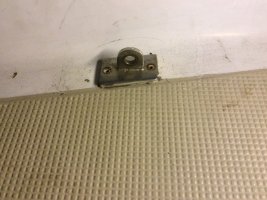adam
Member III
[SUP]
My boat had twin deck fittings underneath the spreaders. I assumed that they were for flag halyards, and as they were both a trip hazard and potential source of leaks I thought I'd just pull them off.
It turned into a minor nightmare.
Tore up the deck, broke two screwdrivers, pulled out the angle grinder to chop it up, and still haven't removed the fitting.
First of all, it turns out the fitting was epoxied to the deck. Secondly, the fitting extends down into the deck connected to who knows what because I can't access the bottom of it.
Anyone know what this fitting was for,[/SUP][SUP] and what anyone was thinking epoxying it to the deck?
[/SUP]

My boat had twin deck fittings underneath the spreaders. I assumed that they were for flag halyards, and as they were both a trip hazard and potential source of leaks I thought I'd just pull them off.
It turned into a minor nightmare.
Tore up the deck, broke two screwdrivers, pulled out the angle grinder to chop it up, and still haven't removed the fitting.
First of all, it turns out the fitting was epoxied to the deck. Secondly, the fitting extends down into the deck connected to who knows what because I can't access the bottom of it.
Anyone know what this fitting was for,[/SUP][SUP] and what anyone was thinking epoxying it to the deck?
[/SUP]
Attachments
Last edited:


